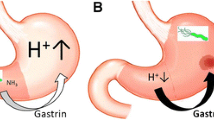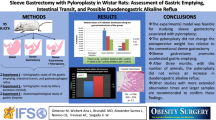Summary
The purpose of this study was to find whether gastric resection enhances the incidence of carcinoma in the remaining part of the stomach. 66 male Wistar rats were subjected to stomach resection according to the Billroth I or the Billroth II method. These rats, as well as control animals with intact stomachs, were fed the carcinogen N-Methyl-N′-nitro-N-nitrosoguanidine (NG). — 25 of 66 animals developed carcinomas in the gastric remnant. Precancerous lesions were seen in 18 rats. The tumours were characterized histologically as adenocarcinomas. They were almost exclusively localized in the region of the gastroenteral anastomosis. The process of tumour formation in the resected stomach was completed within 17–31 weeks on continous administration of NG in a concentration of 120 mg/l in the drinking water. In contrast to these findings, the development of cancer in the intact stomach required on average 41 weeks under the same conditions of NG administration. However, with regard to the incidence of malignant changes, no significant difference was observed between animals undergoing the Billroth I method and those undergoing the Billroth II method.—The results suggest that the resected stomach of the rat is more susceptible to induction of cancer than the intact one. Exposure of the resected stomach to an oral carcinogen induces carcinogenesis predominantly in the anastomotic region.
Zusammenfassung
Die Induktion von Carcinomen im resezierten Magen der Ratte wurde untersucht. Dabei sollte die Frage geprüft werden, ob der operative Eingriff zur Krebsbildung im Magenstumpf disponiert. 66 männliche Wistarratten wurden nach Billroth I oder Billroth II magenreseziert. 5 Wochen nach Resektion erhielten die Versuchstiere N-Methyl-N′-Nitro-N-Nitrosoguanidin (NG) in einer Konzentration von 120 mg/1 im Trinkwasser. 17–31 Wochen nach kontinuierlicher Verabreichung von NG wurden Tumoren im Magenstumpf beobachtet. 25 von insgesamt 66 resezierten Ratten wiesen histologisch Carcinome auf, 18 weitere zeigten präcanceröse Veränderungen. Im Hinblick auf die Carcinomhäufigkeit bestehen keine Unterschiede zwischen Magenresektion nach Billroth I und Magenresektion nach Billroth II. Im Gegensatz hierzu wurden Magencarcinome bei 44 nicht resezierten Ratten erst nach 41 Wochen beobachtet.
Die Versuchsergebnisse legen den Schluß nahe, daß der resezierte Magen der Ratte für die Induktion von Carcinomen empfindlicher ist als das nicht resezierte Organ.
Similar content being viewed by others
References
Craddock, V.M.: The reaction of N-methyl-N′-nitro-N-nitrosoguanidine with deoxyribonucleic acid. Biochem. J. 106, 921–922 (1968)
Davenport, H.W.: Destruction of the gastric mucosal barrier by detergents and urea. Gastroenterology 54, 175–181 (1968)
Freedman, M.A., Berne, C.J.: Gastric carcinoma of gastrojejunal stoma. Gastroenterology 27, 210–217 (1954)
Helsingen, N., Hillestad, L.: Cancer development in the gastric stump after partial gastrectomy for ulcer. Ann. Surg. 143, 173–179 (1956)
Hilbe, G., Salzer, G.M., Hussl, H. et al.: Die Carcinomgefährdung des Resektionsmagens. Langenbecks Arch. klin. Chir. 323, 142–153 (1968)
Ivey, K.J., DenBesten, L., Clifton, J.A.: Effect of bile salts on ionic movement across the human gastric mucosa. Gastroenterology 59, 683–690 (1970)
Kobayashi, S., Prolla, J.C., Krisner, J.B.: Late gastric carcinoma developing after surgery for benign conditions. Endoscopic and histologic studies of anastomosis and diagnostic problems Amer. J. dig. Dis. 15, 905–912 (1970)
Konjetzny, G.E.: Der Magenkrebs, S. 108 Stuttgart; Enke 1938
Krause, U.: Late prognosis after partial gastrectomy for ulcer. Acta chir. scand. 114, 341–354 (1957)
Kühlmayer, R., Rokitansky, O.: Das Magenstumpfcarcinom als Spätproblem der Ulcuschirurgie. Langebecks Arch. klin. Chir. 278, 361–375 (1954)
McCalla, D.R.: Reaction of N-methyl-N′-nitro-N-nitroguanidine and N-methyl-N′-nitroso-p-toluenesulfonamide with DNA in vitro. Biochem. biophys. acta 155, 114–120 (1968)
Morgenstern, L., Yamakawa, T., Seltzer, D.: Carcinoma of the gastric stump. Amer. J. Surg. 125, 29–37 (1973)
Saegesser, F., Jämes, D.: Cancer of the gastric stump after partial gastrectomy (Billroth II principle) for ulcer. Cancer 29, 1150–1159 (1972)
Saito, T., Inokuchi, K., Takayama, S. et al.: Sequential morphological changes in N-Methyl-N′-nitro-N-nitrosoguanidine carcinogenesis in the glandular stomach of rats. J. nat. Cancer Inst. 44, 769–783 (1970)
Stewart,H.L., Snell,K.C., Morris,H.P. et al.: Carcinoma of the glandular stomach of rats ingesting N,N′-2,7-fluorenylenebisacetamide. Nat. Cancer Inst. Monogr. No. 5: 105–139 (1961)
Sugimura, T., Fujimura, S.: Tumour production in glandular stomach of rat by N-methyl-N′-nitro-N-nitrosoguanidine. Nature (Lond.) 216, 943–944 (1967)
Sugimura, T., Fujimura, S., Baba, T.: Tumor production in the glandular stomach and alimentary tract of the rat by N-methyl-N′-nitro-N-nitrosoguanidine. Cancer Res. 30, 455–465 (1970)
Wattenberg, L.W.: Carcinogen-detoxifying mechanisms in the gastrointestinal tract. Gastroenterology 51, 932–935 (1966)
Yamakawa, T., Patin, C.S., Morgenstern, L.: Small intestinal resistance to experimental gastric cancer. Arch. Surg. 105 105–108 (1972)
Author information
Authors and Affiliations
Additional information
This study was supported by a grant from the Deutsche Forschungsgemeinschaft.
Rights and permissions
About this article
Cite this article
Dahm, K., Werner, B. Susceptibility of the resected stomach to experimental carcinogenesis. Z. Krebsforsch. 85, 219–229 (1976). https://doi.org/10.1007/BF00284082
Received:
Accepted:
Issue Date:
DOI: https://doi.org/10.1007/BF00284082




